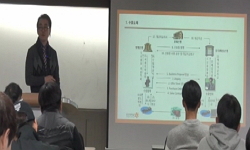Consequential damages from reliance can be recovered only if foreseeability is warranted. The doctrine of foreseeability has been built upon the British case of Hadley v. Baxendale, but has been subject to criticisms including the difficulty in applyi...
http://chineseinput.net/에서 pinyin(병음)방식으로 중국어를 변환할 수 있습니다.
변환된 중국어를 복사하여 사용하시면 됩니다.
- 中文 을 입력하시려면 zhongwen을 입력하시고 space를누르시면됩니다.
- 北京 을 입력하시려면 beijing을 입력하시고 space를 누르시면 됩니다.
https://www.riss.kr/link?id=A108573314
- 저자
- 발행기관
- 학술지명
- 권호사항
-
발행연도
2023
-
작성언어
English
-
주제어
foreseeability ; reliance ; consequential damages ; rate of returns ; contract ; 예견가능성 ; 의존 ; 특별손해 ; 수익률 ; 계약
-
등재정보
KCI등재
-
자료형태
학술저널
- 발행기관 URL
-
수록면
9-34(26쪽)
- DOI식별코드
- 제공처
-
0
상세조회 -
0
다운로드
부가정보
다국어 초록 (Multilingual Abstract)
Consequential damages from reliance can be recovered only if foreseeability is warranted. The doctrine of foreseeability has been built upon the British case of Hadley v. Baxendale, but has been subject to criticisms including the difficulty in applying it in practice. We first attempt to substantiate its efficiency-driven definition especially when there is no relevant contractual stipulation. Our simple theoretic inquiry leads to the proposition that a reliance investment is more (less) likely to be considered foreseeable as its generally-known rate of returns increases (decreases) ceteris paribus. Examining an intriguing case in California reveals that our proposal could provide a workable formula applicable in courts, as an alternative to other rules, for example, making parties to excessively focus on modes of notification. Given that many jurisdictions have increasingly used the foreseeability test, this paper is expected to make a contribution to the literature by helping preserve the optimality of damage measures concerning consequential damages.
참고문헌 (Reference)
1 Cooter, Robert, "Unity in Tort, Contract, and Property: The Model of Precaution" 73 (73): 1-51, 1985
2 Cartwright, Walter, "Timber Stumpage Values vs. Mill Delivered Prices"
3 Fuller, Lon L., "The Reliance Interest in Contract Damages" 46 (46): 52-96, 1936
4 Schäfer, Hans-Bernd, "The Relevance of Law and Economics for the Development of Judge Made Rules: Examples from German Case-Law" 40 (40): 989-998, 1996
5 Eisenberg, Melvin A., "The Principle of Hadley v. Baxendale" 80 (80): 563-613, 1992
6 Gillette, Clayton P., "Tacit Agreement and Relationship–Specific Investment" 88 (88): 128-169, 2013
7 Ayers, Ian, "Strategic Contractual Inefficiency and the Optimal Choice of Legal Rules" 101 (101): 729-774, 1992
8 Johnston, Jason Scott, "Strategic Bargaining and the Economic Theory of Contract Default Rules" 100 (100): 615-664, 1990
9 Kim, Iljoong, "Rethinking the Economic Characteristics of the Major Contractual Damage Measures" 170 (170): 599-615, 2014
10 Muehlheusser, Gerd, "Regulating Damage Clauses in (Labor) Contracts" 163 (163): 531-551, 2007
1 Cooter, Robert, "Unity in Tort, Contract, and Property: The Model of Precaution" 73 (73): 1-51, 1985
2 Cartwright, Walter, "Timber Stumpage Values vs. Mill Delivered Prices"
3 Fuller, Lon L., "The Reliance Interest in Contract Damages" 46 (46): 52-96, 1936
4 Schäfer, Hans-Bernd, "The Relevance of Law and Economics for the Development of Judge Made Rules: Examples from German Case-Law" 40 (40): 989-998, 1996
5 Eisenberg, Melvin A., "The Principle of Hadley v. Baxendale" 80 (80): 563-613, 1992
6 Gillette, Clayton P., "Tacit Agreement and Relationship–Specific Investment" 88 (88): 128-169, 2013
7 Ayers, Ian, "Strategic Contractual Inefficiency and the Optimal Choice of Legal Rules" 101 (101): 729-774, 1992
8 Johnston, Jason Scott, "Strategic Bargaining and the Economic Theory of Contract Default Rules" 100 (100): 615-664, 1990
9 Kim, Iljoong, "Rethinking the Economic Characteristics of the Major Contractual Damage Measures" 170 (170): 599-615, 2014
10 Muehlheusser, Gerd, "Regulating Damage Clauses in (Labor) Contracts" 163 (163): 531-551, 2007
11 Bar-Gill, Oren, "Quantifying Foreseeability" 33 (33): 619-649, 2006
12 Wolcher, Louis E., "Price Discrimination and Inefficient Risk Allocation Under the Rule of Hadley v. Baxendale" 9 : 9-31, 1989
13 Easterbrook, Frank H., "Limited Liability and the Corporation" 52 (52): 89-117, 1985
14 Schäfer, Hans-Bernd, "Lehrbuch der ökonomischen Analyse des Zivilrechts" Springer 2012
15 Verkerke, J. Hoult, "Legal Ignorance and Information-Forcing Rules" 56 (56): 899-960, 2015
16 Cooter, Robert, "Law and Economics" Prentice Hall 2011
17 Bebchuk, Lucian A., "Information and the Scope of Liability for Breach of Contract: The Rule of Hadley v. Baxendale" 7 (7): 284-312, 1991
18 Danzig, Richard, "Hadley v. Baxendale: A Study in the Industrialization of the Law" 4 (4): 249-284, 1975
19 Shavell, Steven, "Foundations of Economic Analysis of Law" Belknap Press of Harvard University Press 2004
20 Ayers, Ian, "Filling Gaps in Incomplete Contracts: An Economic Theory of Default Rule" 99 (99): 87-130, 1989
21 Ben-Shahar, Omri, "Causation and Foreseeability, "in Boudewijn Bouckaert and Gerrit De Geest(eds. ), Encyclopedia of Law and Economics, "Encyclopedia of Law and Economics Vol. 2" Edward Elgar 644-668, 2000
22 Posner, Richard A., "Economic Analysis of Law" Aspen Publishers 2011
23 van Wijck, Peter, "Contract Law and Economics (in the series of Encyclopedia of Law and Economics Vol. 6" Edward Elgar 225-237, 2011
24 Quillen, Gwyn D., "Contract Damages and Cross-Subsidization" 61 : 1125-1141, 1988
25 Diamond, Thomas A., "Consequential Damages for Commercial Loss: An Alternative to Hadley v. Baxendale" 63 (63): 665-714, 1994
26 Perloff, Jeffrey M., "Breach of Contract and the Foreseeability Doctrine of Hadley v. Baxendale" 10 (10): 39-63, 1981
27 Epstein, Richard, "Beyond Foreseeability: Consequential Damages in the Law of Contract" 18 (18): 105-138, 1989
28 Scott, Robert E., "A Relational Theory of Default Rules for Commercial Contracts" 19 (19): 597-616, 1990
동일학술지(권/호) 다른 논문
-
인공지능과 책임공백에 관한 법경제학적 연구: 소비재로서 자동화 기술의 대중화가 초래하는 변화에 관한 분석을 중심으로
- 한국법경제학회
- 정해빈
- 2023
- KCI등재
-
- 한국법경제학회
- 윤진수
- 2023
- KCI등재
-
플랫폼 기업의 내부 정보 활용과 이에 대한 규제가 사회적 후생에 미치는 영향
- 한국법경제학회
- 곽주원
- 2023
- KCI등재
-
상가건물임대차보호법상 권리금회수기회 보호규정의 문제점: 입법론의 관점에서
- 한국법경제학회
- 최준규
- 2023
- KCI등재





 DBpia
DBpia






